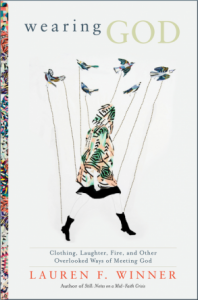Lauren F. Winner’s new book, Wearing God: Clothing, Laughter, Fire, and Other Overlooked Ways of Meeting God, is excerpted in our spring issue of Image. Each chapter explores a single biblical image of God through a mix of exegesis, cultural history, and personal essay. Image’s Mary Kenagy Mitchell recently asked her about her new book, her love of history, her punctuation, and the politics of writing about the Bible:
Image: Your new book is about overlooked images of God in the Bible. I imagine there were some images you found that didn’t make it in. Could you talk about some of those?
LW: In the scriptures there are a lot of animal and nature images for God—water and rock and so on. I’m especially interested in two that liken God to dew and to a tree. I’ve spent time with the tree image, thinking about what trees are, and I have a nascent spiritual practice of tree gazing, where I regularly stare at a magnolia in my yard as a practice of attentiveness.
I love the song “Jesus Christ the Apple Tree.” It’s not widely known, but it’s wonderful. It’s sung mostly in English churches, or at lessons and carols services at Christmas. I had it sung at my ordination, and I make groups of people sing it whenever possible:
The tree of life my soul hath seen
Laden with fruit and always green….
The trees of nature fruitless be
Compared with Christ the apple tree
It’s ostensibly based on a reading of a verse in Song of Songs: “As the apple tree among the trees of the wood, so is my beloved among the sons. I sat down under his shadow with great delight, and his fruit was sweet to my taste” (2:3).
The tree image also illustrates one of the reading strategies I’m after in Wearing God: noting how the scriptures double or treble the figurative language they use. For instance, the scriptures speak of God as clothing and also as the one who clothes. In the instance of arboreal imagery, the Bible speaks of God as tree and also of us as tree.
When we pray the very first psalm, we pray that we will not rush about madly, chatting with cynics and running errands with fools. We pray that, instead, we will be still, devoting our calm energy to the study of God’s word. We will be rooted in God’s word as “a tree planted by the water” (1:3).
At countless protests in American history—civil rights sit-ins, anti-war marches, labor demonstrations—eventually someone takes up the lines of the old freedom song:
We shall not, we shall not be moved.
We shall not, we shall not be moved.
Just like a tree that’s planted by the water,
We shall not be moved.
It means, broadly, that protesters will not be dislodged from their larger goals of a more just society, but also that protestors whom police or hecklers are trying to persuade to leave their immediate site of protest will not be moved.
Preachers through the ages have also used the psalmist’s image, likening Christians to trees that are sustained by—indeed, wholly dependent on—the living water that is God. One monk, Geurric of Igny, was so committed to the idea that he said people are upside-down trees whose roots reach not down into the soil, but up toward the sky “so as to tap into the heavenly Jesus for their divine sustenance.” This seems a lovely image of what God is inviting us to be. I would like to be a tree with roots shooting up, wrapped around and watered by God.
In Wearing God, I didn’t write about trees or dew because the dominant imagery of the Book of Hosea, where both images come from, is of battering. I wasn’t prepared to write a whole chapter about battering language in the scriptures (though I touch on it at the end of the book)—and I wasn’t prepared to cherry-pick these two lovely nature images without addressing the more unsettling context of Hosea.
Image: I’d like to ask you about punctuation. In Image we typically hew to the Chicago Manual of Style, which means we prefer lowercase pronouns for God and Jesus, but you argued for capitalized pronouns, which you use in the book. Could you talk a little about why?
LW: This has always been my practice, and I’ve always had to argue for it. In magazines one often loses the argument. The bottom line for me is that it’s good to have linguistic markers of the way that God is different from us and therefore requires strange speech. I have some formation in this from Judaism, where there’s a practice of writing “G-d,” to avoid fully spelling out God’s name. That’s done for a different reason than capitalizing God’s pronouns, but it’s another orthographical marker of God’s difference.
I assume the history is monarchical. Capital letters tend to signal importance. But saying that, I realize I don’t really know the history of capitalizing God pronouns. Something new to research!
In this case, the whole book is about language for God, and the vast majority is about using ordinary language to try to say something about God. But there needs to be recognition that God requires unusual speech, and when I write about Jesus, the capitalized He’s and Him’s and Himself’s are a reminder of that.
To be continued tomorrow.
Lauren F. Winner’s books include Girl Meets God (Algonquin), Mudhouse Sabbath (Paraclete), Still: Notes on a Mid-Faith Crisis, and Wearing God (both from HarperOne). She has appeared on PBS’s Religion & Ethics Newsweekly and has written for the New York Times Book Review, Washington Post Book World, Publishers Weekly, Books and Culture, and Christianity Today. She teaches at Duke Divinity School.












